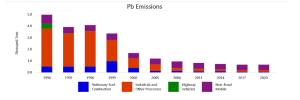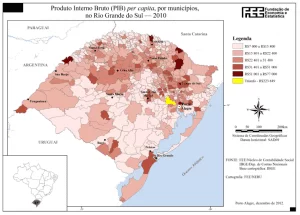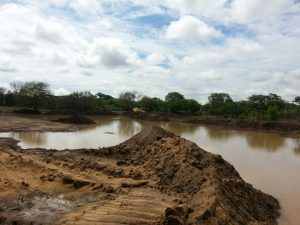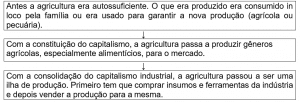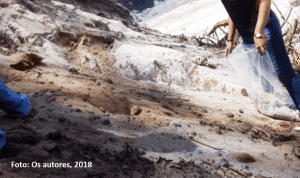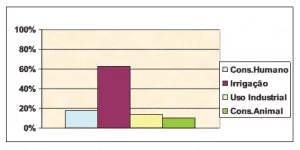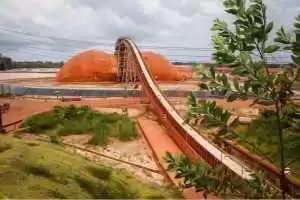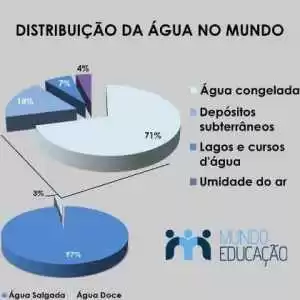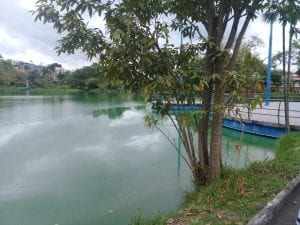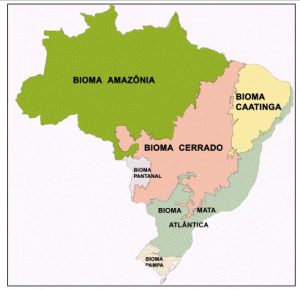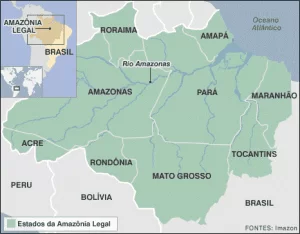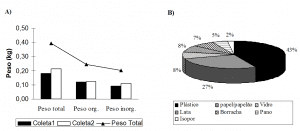ORIGINAL ARTICLE
SOUZA, Keulle Oliveira da [1], TRINDADE, Gleice Tavares [2], FECURY, Amanda Alves [3], DIAS, Cláudio Gellis de Mattos [4], MOREIRA, Elisângela Claudia de Medeiros [5], DENDASCK, Carla Viana [6], FERNANDES, José Guilherme dos Santos [7], PIRES, Yomara Pinheiro [8], PINTO, Manoel de Jesus de Souza [9], OLIVEIRA, Euzébio de [10]
SOUZA, Keulle Oliveira da. Et al. Mineral exploration in the Brazilian Amazon: Labor relations and internal migration in the Municipality of Pedra Branca do Amapari-AP. Revista Científica Multidisciplinar Núcleo do Conhecimento. 04 year, Ed. 12, Vol. 08, pp. 05-28. December 2019. ISSN: 2448-0959, Access Link: https://www.nucleodoconhecimento.com.br/environment/mineral-exploration, DOI: 10.32749/nucleodoconhecimento.com.br/environment/mineral-exploration
ABSTRACT
This article consists of an analysis of the social and economic consequences that the new mining cycle triggered in the state of Amapá generated and is generating for the municipality of Pedra Branca do Amapari (PBA). Specifically, the migration process and the new working relationships established in the city as effects caused by the activity of mining ore in PBA. To this end, it was based on the point of analysis that mineral exploration in PBA is part of the process of occupation and regional exploitation of the Amazon and that, therefore, it cannot be analyzed only from the point of view of the historical, social and economic context of Amapa, but as part of the process of historical colonization of the region that followed, over the centuries, different economic models and forms of intervention.
Keywords: Mining, migration, work relations, Pedra Branca do Amapari, Amazon.
1. INTRODUCTION
“The history of Amapá is confused with mineral exploration in the state, since the Federal Territory of Amapá was created in 1943 and, in 1946, a manganese deposit is discovered in Serra do Navio” (BARBOSA, 2011, p. 8). In the 1980s, the mineral focus turned to the municipality of Calçoene with the exploration of gold in the city. In the 1990s, mazagão and vitória do Jari became the target of mineral activity with the exploration of gold and kaolin, respectively. And later, in 2004, attention turns to Pedra Branca do Amapari with the exploration of gold and iron in the municipality (BARBOSA, 2011).
Thus, the present work analyzed the social and economic consequences that the new mining cycle triggered in the State of Amapá, belonging to the Brazilian Amazon region generated and is still generating, for the municipality of Pedra Branca do Amapari (PBA). More specifically, the migration process and the new working relationships established in the city, as effects caused by the activity of mining ore in PBA.
To this end, we start from the point of analysis that mineral exploration in PBA is part of the process of occupation and regional exploitation of the Amazon and that, therefore, it cannot be analyzed only from the point of view of the historical, social and economic context of Amapa, but as part of the process of historical colonization of the region that followed, over the centuries, different economic models and forms of intervention , but with a common characteristic: “the occupation was done invariably and still today is done from external initiatives”. (BECKER, 2001, p.135)
Therefore, we affirm that the key point of this work lies in the two main effects of the process of exploitation of natural resources in the Amazon and that they interconnect as they are part of the same phenomenon, that of physical expansion of capital. As a consequence, population displacement sits and a new dynamic in the world of work at regional level occurs. It is worth mentioning that this process follows a historical realignment of the role that the Amazon has for private capital, especially the international one.
Currently, this exploration is marked by the presence of foreign capital, with large investments in the energy, mineral, timber and metallurgical sector, with the objective of producing basically primary commodities for export. In PBA, the exploration of the ore has also been following this logic, since the majority of the production generated from the municipality is also for export to the international market.
The processes of regional occupation have historically been followed by large migratory flows and the change, in part, in the region’s labor relations, thanks to the demand for a workforce generated in such processes. Reality that was also observed by us in Pedra Branca do Amapari. In recent years, the city has suffered a population outbreak caused by the realization of mineral activities in the municipality that, in processes like this, function as a cause of attraction of population displacements.
Thus, we analyze the social effects of mining in the municipality from the impacts on regional development, as well as a brief contextualization of the urban problems generated by population growth and disordered territorial occupation, from the dynamics of occupation and exploitation in the Amazon, bringing it to the Amapaense context.
Thus, we divide the present into four parts for a better development of the discussion. The first makes a brief contextualization of the municipality that was chosen as our object of study. The second takes a synthetic approach to the historical process of occupation and exploitation of the Amazon. The third part analyzes the city of Pedra Branca, its population increase and the labor relations within this regional context of Amazonian exploration and in the fourth we discuss the results of the field research, which was carried out by the observational method.
2. PEDRA BRANCA DO AMAPARI: A BRIEF CONTEXTUALIZATION
Despite being officially created only in 1992, Pedra Branca do Amapari has a long history. In the region, records of gold exploration have been found since 1935 when, at that time, there was plenty of metal and the exploitation was handmade by prospectors. During this period,
About 500 to 600 snowmen explored the river. In 1938, the number of ore explorers already reached the house of 5,000 people, some seeking new meters to extract gold, others walking to the place of extraction of those who had arrived in front, others, finally, only sucking the sweat of those who worked, selling goods at very high prices (SECRETARIA DE MEIO AMBIENTE de PBA, 2013, p. 01).
However, “in 1940, production had declined and the majority of the population began to disperse” (SECRETARIA DE MEIO AMBIENTE de PBA, 2013, p. 01). From 1950, the first residents of the village of Pedra Branca began to emerge, motivated by the discovery of manganese in the neighboring municipality, which is about 20 km from PBA, Serra do Navio.
With the implementation of the mining project by The Industry and Trade of Ores S.A. (ICOMI), for the exploration of the manganese deposits of Serra do Navio, access to the region was facilitated through the construction of the Amapá railway (EFA), responsible for the interconnection of the municipality to the Port of Santana for the flow of ore (Figure 1). With this, families were migrating to the region, mainly in search of job opportunities at ICOMI, but also in search of gold in the fields and land aimed at agro-food cultivation, especially for those coming from the northeast. However, the city does not directly benefit from this exploration and is not contemplated with the urbanization policy that was developed in Serra do Navio (BARBOSA, 2011).
Figure 1: Men working at the beginning of the construction of the Amapá Railway – EFA
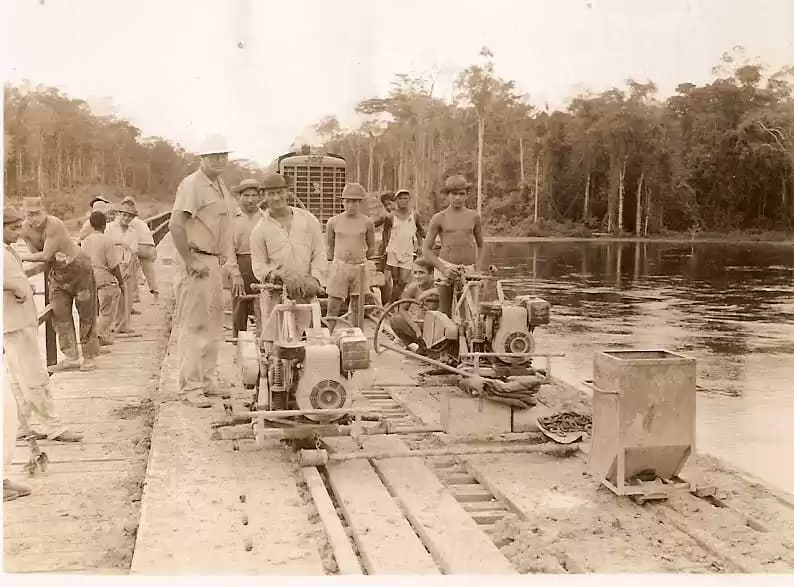
Source: Secretary of Environment of Pedra Branca do Amapari.
Until 1992, Pedra Branca remained only a small village of residents, who lived basically from agriculture and gold mining. From then on, the municipality is officially created and with this acquiring new social dynamics, since there was now the need to operate a political-administrative structure in the city. However, PBA continued to be politically and economically, of low relevance to the state, a situation that begins to change significantly from 2004 with “the harbinger of research in the area and the mining facilities” (RIBEIRO; SILVA, 2010, p. 21). From then on, “the urban nucleus of the municipality was the scene of accelerated migratory movements in search of employment and consequently improvements in life” (Idem).
With the exploration of gold and later iron, through the Mining in Pedra Branca do Amapari (MPBA), it was also increasing the circulation of goods and, consequently, the tax collection of the municipality. In addition, the city also collects the royalties it has received from ore mining companies operating in PBA, thus having a significant increase in its revenue.
However, the impacts of mineral exploration on the municipality are not only financial. With the installation of mineral enterprises in the city, there is also a radical change in its social, political and urban configuration. The city has suffered the largest population increase in the state of Amapá in recent years. According to the last ibge demographic census, Pedra Branca has about 10,773 inhabitants (IBGE, 2010). Compared to the previous census of 2000, when the city had only 4,009 inhabitants, PBA had a population increase of 168.72% in ten years, and also estimated that by the end of 2019 the population reached a total of 16,502 people, obtaining a population growth rate higher, including that of the State itself.
However, its population growth was not accompanied by planning, which led to the emergence of urban and social problems and the worsening of existing ones, such as lack of basic sanitation, lack of urban mobility policy, deficiency in garbage collection and cleaning service, etc., all consequences of the city’s disordered growth, influenced by the intense flow of migration to the municipality.
Like any place where the demographic explosion occurs, derived from seasonal economic activities and without planning, PBA suffered and suffers from the migratory force resulting from the presence of social dynamics that confront differentiated views about practices and values when we consider the importance of space for its users. This is because migration processes are almost always touched by work reasons transform the environment and are the right-reason for confrontations between locals and arrivals, and the category is important work to think of “migration as a social process and migrants as agents of this process” (SILVA, 2005, p. 54). That is, the fact that the demographic avalanche intensified in PBA resulted from the migration process of work, the search for enrichment, which caused the local population to increase by almost 200%, which generated a new social process full of conflicts and socio-environmental impacts caused by this new anthropization. It is important to know in detail about the migrant narratives, which are not in the documents, because this high migration in PBA appears only as data “without faces”, being necessary the attentive listening of the agents of this migration, because “the migrant narrative is a mark of the subject moving out of his Aboriginal experience, situated in a new locality and territoriality that moves in the interstices of society” (FERNANDES , 2006, p.163).
In fact, PBA is one of several indices in the Brazilian Amazon in which mineral exploration is synonymous with environmental devastation and social inequalities and civilizing decay, which we will note more prominently below.
3. MINERAL EXPLORATION, LABOR RELATIONS AND INTERNAL MIGRATION IN THE BRAZILIAN AMAZON
For analysis purposes, in this article we will evaluate the process of mineral exploration most recently triggered in the municipality of Pedra Branca do Amapari and, from then on, its intense migratory flow and the new dynamics of labor relations in the city, from an overview of the dynamics of mineral exploration in the Amazon and its effects, related to the process of historical occupation of the region , taking into account the process in question in PBA as an integral part of this Amazonian regional context.
The Amazon, in its history, has been the target of major economic interventions, due to the importance it has for capital, especially international. Not by chance that “its occupation took place in wanton outbreaks linked to the momentary valuation of products in the international market, followed by long periods of stagnation” (BECKER, 2001, p. 135).
Historically, in these processes of interventions followed different models of occupation and economic development, such as drugs from the backcountry, the rubber cycle, and more recently, the large agricultural and mineral projects that caused significant changes in the region, mainly influencing its socio-spatial restructuring through migratory flows, formation of new urban centers and the creation of basic infrastructure in strategic sectors for development and capitalist production such as the energy sector , port and land transport (railways, roads), for example, necessary to the exploration model that has been in force in a consolidated manner since the 1970s (RIBEIRO; SILVA, 2010).
The process of mineral exploration in an industrial way in the Amazon began at the time of the then Federal Territory of Amapá, when the exploration of manganese ore in the municipality of Serra do Navio-AP represented the constitution of the first major mineral enterprise in the region, as Monteiro states:
This mine was built in a conjuncture marked by the establishment, in national terms, of a new political regime and by the reorientation of the relations established between the State and the economy. It was the end of the dictatorship of Getúlio Vargas and the new Constitution, promulgated in 1946, replacing the 1937 Charter, was strongly inspired by the principles of economic liberalism (MONTEIRO, 2005, p. 187).
Thus began in the Amazon the first major process of mineral exploration in the region, carried out by the company then called Indústria e Comércio de Ores Sociedade Anônima (ICOMI S.A), which began in 1950 and lasted about 40 years.
Thus, manganese ore extraction was, for about two decades, the only significant industrial mineral extraction in the Brazilian Amazon, a context that began to change substantially since the military coup of 1964 in Brazil. From then on, a new national policy of regional occupation was established, which was consolidated in the 1970s, based on the vision of the imperative need to occupy the region territorially. “The military dictatorship gives the occupation process the meaning of an expansion of large capital over an area not yet explored in its natural resources” (FERREIRA; CASTRO, 2009, p. 07). This new policy presupposed its occupation combined with the exploration, through large projects, of its known riches, among them, minerals, as Becker states:
Since 1968, fiscal and credit mechanisms have subsidized the flow of capital from the Southeast and abroad to the region, through official banks, particularly Banco da Amazônia S. A. (Basa). On the other hand, migration was induced through multiple mechanisms, including colonization projects, aimed at the settlement and formation of a local labor market (BECKER, 2001, p. 138).
However, the region had – and still has – enormous physical obstacles to its occupation/exploitation. Hence the articulation of the government itself of development policies for the Amazon that prioritized mainly private capital interests, aiming to attract investments to the region.
In this sense, in 1974, the government then created the Agricultural and Agromineral Poles of the Amazon – Polamazônia, aiming to generate development centers in the region, mainly through large mineral exploration projects.
In the ‘Amapá hub’, the tax incentives policy was used by Icomi to implement a pelotization plant, (…). In that ‘polo’ also entered into operation the first company dedicated to the industrial extraction of kaolin in the Amazon. This was the Caulim da Amazônia (Cadam), created as part of the investments of the American millionaire Daniel Ludwig in the area of Jari forestry (MONTEIRO, 2005, p. 188).
In addition to the tax and credit incentives given by the Brazilian government, he also had to enable the basic infrastructure for the operation of these projects, such as roads, railways, ports, etc. for the exploitation, not only mineral, of the region’s natural resources. Since then, “circulation and telecommunications networks have been carried out, through which new flows of labor, capital and information have been mobilized” (BECKER, 2001, p. 139).
However, the government faced difficulties with financing infrastructure works. Thereby
As the Federal Government needed to expedite the installation and start of operation of mining-metallurgical projects, it created, in 1980, the Grande Carajás Program (PGC). An attempt to coordinate the execution of existing projects in the area (especially the Carajás Iron Project, Albras, Alunorte, Alumar and the Tucuruí Plant) and to further concentrate state resources and those from tax and credit incentives (MONTEIRO, 2005, p. 190).
In this context of attracting investments to the region, then came the installation of large mineral projects and as a consequence of these, a series of social effects for the Amazon. Among them, the one that interests us most directly in this article, the dynamics of labor relations and the migration process in the Amazon.
Private and national capital investments; the viability of infrastructure in the region; and the installation of large miningn[1] projects were partly responsible for attracting a certain population and changes in the dynamics of regional labor relations. “The post-1960s population expansion towards new territories (…) configured a new map of Brazil. The border for the contribution of investments, policies and population ‘marched’ towards the Amazon” (MENEZES, 2001).
It is worth mentioning that the region in question remains the region with the lowest population density in the country and that the changes mentioned here by us, took place, especially in the context of cities that host or host large – or even medium and small – mineral exploration[1] projects such as Pedra Branca do Amapari, for example.
This regional reality stemmed from the process of physical expansion of capital that expands the forms of increased economic exploitation. The Amazon has always been a region of low economic productivity and, currently, as throughout its history of colonization, has basically served as a producer of commodities for the world market. However, where economically productive cycles were established, resulting from the installation and operation of large mineral and energy enterprises1 there was a population increase and changes in the social and spatial configuration of the cities.
For Singer (1980) and Sampaio (2011), the migration process is directly related to the development of capitalism, especially with the industrialization process caused by it. He states that the main causes of migration flows are precisely the regional inequalities caused in these industrialization processes. In other words, the capital development process leads to the concentration of productive activities, generating regional inequalities that induce migration processes.
The region, in recent decades, has undergone a period of strong intensification of spatial and territorial organization, especially in the first areas where roads and railways were opened, where new urban centers have emerged and where large energy and mineral projects, mining activities, extensive agriculture, etc. have been and are being operated. These activities were developed in the region according to the physical expansion of capital, aiming at increasing regional productivity (MENEZES, 2001).
In this sense, we analyze this process in the Amazon as highlighted by Leff (2006) and Ferreira e Castro (2009, p. 04) highlights: “historical materialism seeks to account for the social structure that converts nature into work objects, natural use values capable of being incorporated into the process of producing wealth and work”.
Thus, in the Amazon there were changes resulting – despite the total incorporation of its territory to the historical and current processes of European and North American colonization – of changes in the dynamics of territorial occupation of the regional region. The phenomenon of migration is a clearly visible effect in the region, because cities, places, microregions, etc. that house or house mineral enterprises, received a population increase above the general average of the Amazon (IBGE, 2010). Pedra Branca, for example, received a population increase equivalent to 9.00%, above the average of the State of Amapá itself (BARSOSA, 2009).
The global dispute over the region’s natural resources makes the dispute for control of the territory crucial in the geopolitical context of the Amazon. However, this model of regional occupation adopted by the national state, that is, a predatory explorer model, consolidated from the 1970s on, contrasts sharply with the population, economic, cultural, political and social dynamics of the region.
When it comes to work, it was the economically productive cycles, which produced/produced for the foreign market, that is, for export to the international market, which were responsible for introducing forms of work typical of capitalist societies and urbanized in the Amazon, however, to this day not dominant, because in the region still prevail today labor relations, to a certain extent, detonated from the labor relations typical of the capitalist world of work, characterized mainly by informality and extractivism.
Sociocultural and environmental heterogeneity is one of the greatest characteristics of the Amazon region. The organization of work itself in the Amazon presents diversity that cannot be understood only under the logic of capital. There are peculiar forms of unability that go back to traditional cultures and that fall within the scope of the survival strategies of forest peoples (TORRES, 2001, p. 01).
Thus, it is important to understand that labor relations in the Amazon cannot be understood solely through the prism of salaried industrial work, which is a relatively recent category in the Brazilian Amazon and which gains notoriety, mainly, from the middle of the 20th century (TORRES, 2001).
First of all, we must analyze that the economy of the Amazon from the Portuguese colonization until the middle of the twentieth century, was strongly marked by extractive activities. The various economic and cultural modes of the region, that is, the various forms of occupation ability that exist are due to the operation of strategies, whether traditional or emerging, aimed at ensuring the survival of amazonian populations. Through traditional strategies we understand the forms based on the maintenance of the family social structure, economically, little integrated into the market. As emerging, we understand precisely those based on the peculiar labor relations of industrial societies (TORRES, 2001).
According to Simões (2009), in the presence of the continuity of developmental policies for the region, in which the basis for the installation of new enterprises continues to be access to the amazon’s natural resources at low cost and without considering the social, cultural and environmental aspects of the local population, it is possible to affirm what most studies on the economy of the region have already analyzed : The Amazon is characterized mainly by exporting raw materials without any planning of productive diversification or local structuring.
Thus, we highlight how the process of territorial occupation of the region engenders processes of exploitation of natural resources, taking into account the interests of the productive restructuring of the world economy and the physical expansion of capital, directed by the Brazilian State, to the detriment of the interests and peculiarities of the local population. As every process of physical expansion of capital demands a contingent of the workforce to be carried out, in the Amazon it does not occur differently, thus becoming a region with factors of population attraction and consequently, suffering an intensification of migratory flows in its direction and modifying the dynamics of labor and socio-spatial relations of the region.
4. LABOR RELATIONS AND MIGRATION IN PEDRA BRANCA DO AMAPARI: SOCIAL EFFECTS OF MINING IN THE MUNICIPALITY
The municipality of Pedra Branca do Amapari, created in 1992, seeking to reorganize the Amapá territorially, politically and administratively (PORTO; BIANCHETTI, 2005) had, until recently, a certain irrelevance in the amapaense economic and political scenario, because the city was only a small city of the state without intensity in any economic activity.
From the discovery of gold mines, PBA began to have a specific population attraction, but it is worth noting that the first exploration of these mines was not industrial, but in a mining way, as Barbosa states: “until 2004, the economy of the municipality was moved: by the mineral exploitation of gold, in an artisanal way by the prospectors; timber exploration, to meet EFA’s maintenance services; and also by subsistence agriculture” (BARBOSA, 2001, p. 93).
Since 2000, with the consolidation of a favorable environment for the export of mineral commodities and the metallogenetic potential of Amapá, there was a return on investments in mineral research in the state. With this, new mineral deposits were discovered, where some have even become concrete ventures, causing the mineral sector to reacquire a prominent place in the Amapaense economy (OLIVEIRA, 2010).
Behold, in this amapaense scenario, of investments in research in the mineral sector, the deposits of gold and iron found in the municipality of Pedra Branca do Amapari come into question. On this, we highlight:
Also in 2005, the project for the valorization of amapari gold deposits was inaugurated by the company Mineração Pedra Branca do Amapari LTDA. ” MPBA . In four years of operation, the company extracted more than nine tons of gold (…). At the moment, the project undergoes a revaluation of primary ore reserves, with a return of mining forecast for 2014. Also in the Region of Amapari, near the gold mines of MPBA, important deposits of iron ore were found, whose potential attracted investment in the exploitation of these resources by the company MMX Mineração e Metálicos (OLIVEIRA, 2010, p. 26).
Currently, the exploitation of iron ore in PBA is carried out, in addition to National and International Companies, also have an amount of outsourced companies that provide services to them, thus creating a network of direct and indirect jobs, generated by mineral exploration in the municipality, responsible for the great population attraction of the city in recent years.
Given the installation of mineral enterprises in the city, the result is the formation of new urban centers, such as what happens throughout the Amazon region, where cities around large enterprises substantially alter their socio-spatial structure due to the disordered population increase, a common aspect in these processes.
Thus, what occurs in Pedra Branca is no different from what happens in other cities of the Brazilian Amazon. With the implementation of industrial mineral exploration, the dynamics of labor relations and the socio-spatial constitution of the municipality are also altered. From the context of the installation of large projects, a network of services needed directly and indirectly to the execution of these, which are directly related to the world of work, is developed, especially in a region of low economic productivity such as the Amazon and in a state in condition, as is the case of Amapá.
Only the installation of projects is sufficient to directly alter the labor relations in the city, because as representatives of large capital, companies that exploit ore in PBA, introduce forms of work typical of industrial societies. In addition, there are also the consequences of its facilities; the news that the city houses mineral exploration enterprises becomes sufficient for the attraction of people from other cities motivated, above all, by economic interests, looking for prospects for improvements in material conditions of existence, thanks to the increase in the supply of employment and income, whether directly in mining activities, or as a consequence of the network of services necessary and generated by it , as well as the consequence of the restructuring of the social and economic relations of the city that require new adjustments that also influence labor relations.
It is worth noting that the changes in the dynamics of labor relations are not only related to the activities necessary for the execution of mineral exploration in the municipality. The theories of migration in Brazil show that most migratory movements, commuting or not, are, above all, motivated by economic interests, placing work as the core of this relationship of migration and economy.
However, it is noteworthy here that migration also has motivational characteristics different from what is considered the main reason for migration worldwide. These characteristics differ when dealing with the age group and gender of migrants. What we want to say is that migration is also motivated by family contexts. Men are mostly motivated by economic interests, while women and children are motivated, above all, by family reasons (JANNUZZI; OLIVEIRA, 2005).
In this sense, we need to understand that the two reasons are entirely related; the family motives of women and children are associated with men’s economic motives. That is, when it comes to the same family, most women and children migrate to accompany their husbands and fathers, respectively. It is also important to highlight that economic reasons do not lose their centrality in this relationship and that it is directly related to the world of work (JANNUZZI; OLIVEIRA, 2005).
Consequently, this generates a chain of demands to be met, in addition to directly influencing the development of local trade. Thus, it is perceived that the population increase of the municipality is directly related to the period in which the research began and the effective industrial mineral exploitation in the city. With an intense migratory flow, in addition to the population increase there are also changes in the urban configuration in the city, as Barbosa (2009) points out, the following:
With the installation of the two mining companies, the municipality becomes the focus of the various segments of the economy and, with this, the city was impacted by the population density. The government, however, did not adopt mitigating measures to adapt the urban area to the new population reality or structure the city with social equipment in order to serve the municipality of Pedra Branca (…) (BARBOSA, 2011, p. 93).
The binomial population mobility and urbanization is one of the most painful aspects of the process of regional occupation, since cities did not have the conditions of resources and time to absorb migrants (SUDAM, 2011). Pedra Branca, as a city in the Amazon region, also experiences this context. The migratory process has brought serious social consequences due to the lack of urban planning that prevents the city from constituting itself as a space capable of absorbing the population increase and generating social, economic, political and urban development for its population.
In addition to the population increase, PBA has undergone a spatial restructuring that includes the creation of new neighborhoods and the expansion of the city’s urban area. In addition, the main housing locus in the city has also changed, i.e.:
Regarding the distribution of the population by location area, in 2000, the municipality was predominantly rural, because 65.98% of its population was occupying the rural area. However, in 2007, the highest population concentration became urban 55.69%, following the trend of the state of Amapá and Brazil; in the 2000 Census, they had 89.0% and 81.20% of people living in urban areas, respectively. The 2010 Census confirmed this fact, showing that the Brazilian population is more urbanized than for 10 years, with a record of 84.35% of the population living in the urban area (BARBOSA, 2011, p. 91).
The city of Pedra Branca grows without any instrument to regulate territorial occupation (BARBOSA, 2011). The municipality has only 3.9% of private households with basic sanitation considered adequate; 67.7% is considered semi-adequate and about 28.4% of households have completely inadequate sanitation (IBGE, 2010). Garbage collection is regular only in some neighborhoods and street cleaning does not occur throughout the city.
According to Ribeiro e Silva (2010), PBA does not have a master plan that organizes and regulates urban growth in the municipality. The large population growth that the city has been experiencing in recent years has had consequences such as the lack of urban infrastructure, lack of basic sanitation, disordered territorial occupation, housing in precarious conditions, mobility difficulties and poor accessibility conditions, etc.
Thus, it is perceived that the high intensity of the migratory flow that the municipality has been going through, resulting from the process of execution of mining activities carried out by industries of great capital that caused the increase in the demand for labor in the city, generated social, economic and urban impacts in PBA, so that it was possible to analyze that the city did not have a political-administrative structure to face them or technical capacity to manage them. That is, the growth of the city was not accompanied by a direction ordered by the government, resulting in the municipality the problems mentioned earlier by us that directly impact the lives of the population living in PBA.
5. ANALYSIS OF FIELD RESEARCH DATA
This new economic, political and social moment that the city of PBA goes through are reflections of the new relations established in the municipality resulting from the triggering of ore exploration. From the beginning, we started from the point of view that the ongoing process in the city is part of a regional process of occupation and exploitation of the Amazon related to the international process of colonization of the region, directed by the national state, serving the interests of private capital. As a consequence, we have the development of new labor relationships and a population increase influenced by the demand for labor generated in these processes.
The field research carried out by us in the municipality in question was important as it served to support us concrete data on the reality of the city and to make us develop a better understanding of the socioeconomic, political and environmental impacts of this current process in PBA. In such a way, it also served to corroborate the work hypothesis raised by us at the beginning of the research, that in contexts of mineral enterprises in addition to the increase in the migratory flow, the dynamics of labor relations are also altered, using this theoretical category in the reality of the municipality analyzed by us.
In the research conducted by us it was still possible to realize that, despite the great population attraction and the establishment of common working relationships in industrialized societies, formal working relationships still prevail in the city. However, although the formal relationships are still the most common, there is not such a great disparity between the level of people working on a signed or not portfolio, or even those who have a formal employment relationship, but not under CLT.
Of the universe of workers interviewed by us, 55.88% declared that they did not work on a signed license, while those who declare that they perform some type of work with the signed portfolio represented 44.11%. It is important to say that all those who carry out activities in the mining areas, declared to have established formal working relationships, something typical of the labor policy of large companies based on the broadest possible control of risks.
Regarding the migration process in the city, we observed a sharp population growth since the moment of the implementation of the first ore company, destined to explore gold mines in the municipality. Thus, we realize that “internal migrations are always historically conditioned, being the result of a global process of change, from which they should not be separated” (SINGER, 1980, p. 217).
The field research pointed out that of the population living in the municipality, only 8.82% are from PBA, the majority, 91.17%, come from other cities or states. Therefore, demonstrating that the city, in this context of operation of large mineral enterprises is, of course, a place of population attraction. On this, Sampaio, when analyzing what Singer addressed about migration, highlights:
If, on the one hand, there are those regions whose population emigrates, on the other hand, the regions that receive this population present what has become called attraction factors. The most important attraction factor is the demand for labor derived from industrial activities and public services, private or autonomous. This demand is a function of the size and composition of the product generated by the urban economy (SAMPAIO, 2011, p. 63).
It is worth mentioning that according to IBGE (2010), even with a partial increase in the population of the municipality, it was from 2007 that the city began to have an intensification with regard to its population growth, a period that coincides with the process of intensification of mineral exploration in PBA.
In Figure 2, we demonstrate the intensity of this process experienced in the city. The vast majority of the population comes from other cities and most of the North region, evidencing the timeliness of internal migration processes in the Amazon, engendered by the processes of territorial occupation aiming at the exploitation of the region’s natural resources, in this case here, of the city of Pedra Branca do Amapari.
Figure 2: Migrant population and natural population of PBA.
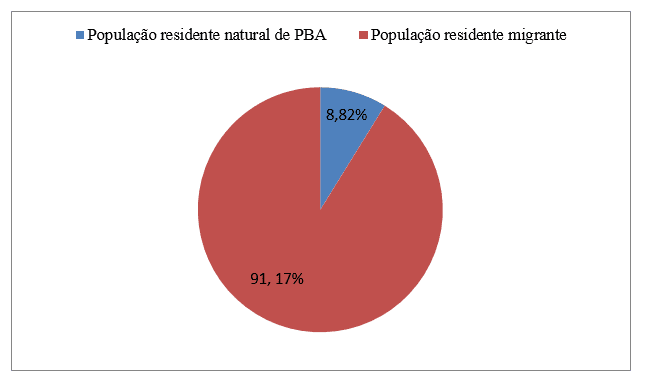
We should also show that of these 91, 17% of migrants, 80.6% are from the North region itself. While this brings us back to the processes of internal migration in the Amazon itself. The states of Pará and Amapá are the places where we most identify people. Of these 80.6%, the two states represented about 48% each of the unnatural population of PBA. Those who come from others in the northern state accounted for only 4%.
The Northeast was the second region where we most identified migrants. Of 91.17% in PBA, 16.12% come from this part of Brazil. When stratified by states, the survey data show that the majority come from the state of Maranhão, which alone came to represent 60% of the migration from this region. Although we identified people from other regions of the country, only these two regions totaled 96.77% of the city’s migrant population, with only 3.22% coming from other regions of Brazil. (Figure 3).
Figure 3: Migrant population in PBA from the North region.
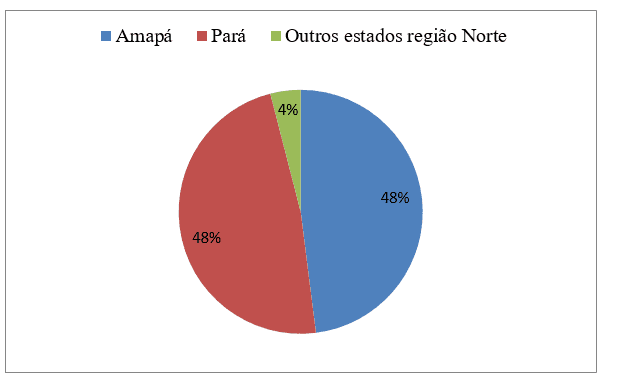
The survey also asked migrants what is the main reason for moving to PBA. Of the 91.17% from other cities, 93.54% stated that the main reason is related to work, such as the search and greater supply of employment, a more favorable environment for trade and the search for better living conditions, related to greater job opportunities.
This point, which caught our attention the most, reveals the basis of population displacements in Brazil: the economic issue. Although the phenomenon of migration has peculiar and multifaceted characteristics, the nerve point of population displacements still remains the search for better material conditions of existence. As Singer (1980) and Oliveira (2011, p. 13) state, “in the place of destination would be the factors of attraction, which would guide the flows and places to which they would be destined. The main factor of attraction would be the demand for the workforce, also understood as “economic opportunities”.
When we asked about the fact of the claim to return to the city of origin, 54.83% stated that they have no intention of returning. Those who answered who think about this possibility represent 38.70% and those who opined stating that they may return represented 6.45%. It is worth noting that of the 54.83% who said they do not intend to return, 88.235% said that the main reasons are related to the offer of employment and living conditions in the place of origin. Of those who said they intend to return, half stated that the family is the main reason for the return.
With regard to the public health network of the municipality of PBA, the city has a Mixed Unit and a Basic Care Unit, both of low complexity, which requires those who need medium and high complexity care to move to Macapá, the state capital. In addition, we also identified the functioning of the one that represents one of the greatest advances of the Unified Health System – SUS, but has enormous structural difficulties of functioning, the Family Health Program
Regarding basic sanitation, 67.64% said they did not have piped water through public supply. According to them, the home water supply is made through amazon well or artesian. Those who claimed to have piped water accounted for 32.35%, however, they stated that they were not treated. In this situation, it occurs that the piped water to which the residents referred, it is the water coming from the so-called “bathhouse”. The installation was made possible by the government, but the officials of the Municipality of Pedra Branca do Amapari declared that it has no treatment, being unfit for consumption.
Regarding garbage collection, 82.35% of the interviewees stated that it occurs regularly. In these cases, in some neighborhoods such as the Center, for example, it occurs daily, but in others, it occurs 3 times a week. Those who stated that the collection does not occur regularly totaled 11.76%. It is important to highlight that for levels of analysis, we consider the collection performed less than 3 times a week. On average, the majority stated that the collection in these cases occurs about 1 to 2 times a week. Those who stated that the collection does not occur represented 5.88% of the interviewees. These stated that the collection does not occur because the neighborhood is not recognized in the city hall and, therefore, does not officially exist.
Finally, we can highlight an important issue: the neighborhoods in which the collection takes place irregularly or does not take place, are in territories far from the city center and are part of the process of spatial restructuring of the municipality, caused by the great population growth and disordered. Thus demonstrating that urban relations in the city are reflections of unequal socio-spatial development engendered by the processes of territorial occupation and productive development of the region.
From these data, it was possible to more accurately analyze the social effects that mining activity generated in the municipality. The demand for the labor force, consequently, caused a large disordered population growth, which, in turn, due to the lack of municipal urban planning, aggravated existing problems such as the lack of basic sanitation, the disordered occupation of the soil and the inefficiency of public services.
6. FINAL CONSIDERATIONS
The historical process of colonization of the Amazon followed different economic models according to historical moments and the process of productive capital restructuring. On a global scale, the region has an important role for the international market and the entire exploration process currently directed in the region serves to fulfill it.
Thus, the current observed exploratory model of the region obeys the interests of private capital, generating processes of occupation that prioritize the development of capital in contrast to the social, cultural and environmental relations established in the forms of occupation induced by the population of the region. Thus, we analyze the ongoing process in PBA as an integral part of this process of exploration and regional occupation and, as such, suffers the consequences of a directed process that prioritizes exogenous forms of regional development.
Thus, we noticed that the mineral exploration carried out in Pedra Branca do Amapari is related to the context of the installation of large mineral, energy and metallurgical projects in the region, which, in turn, are associated with the aforementioned regional process. It is also important to highlight that the right to exploit any mineral reserve is granted by the State, thus revealing that the form, as today is guaranteed the licenses to mining companies comply with the logic of favoring private capital.
The high rate of population growth revealed that demand for the workforce continues to be the basis of population displacements in the Amazon and that migration and labor relations are intrinsically linked concepts as both are part of the process of physical expansion of capital and productive restructuring of the economy. Pedra Branca do Amapari, from the moment it started to demand a greater workforce to meet the objectives of ore exploration activities in the city, became a place of population attraction, being the target of migrants from all regions of the country.
The mineral exploration operated in the municipality brought to the city social, economic, political and urban consequences that were responsible for changes in the social and spatial configurations of the city. Thus, we realize that the impacts of mineral exploration go beyond the increase in financial collection and population attraction. The economic gains, in these cases, if not well used and used to direct planned processes of urbanization and generation of quality of life, become without social function and unable to meet the social demands of the population.
REFERENCES
BARBOSA, R. G. Os efeitos da mineração na arrecadação e no processo de urbanização do município de Pedra Branca do Amapari. Dissertação de Mestrado, Universidade Federal do Amapá – UNIFAP, 2011.
_______________Impactos da compensação financeira sobre a exploração mineral no processo de urbanização do município de Pedra Branca do Amapari – 2004/2008. PRACS: Revista Eletrônica de Humanidades do Curso de Ciências Sociais da UNIFAP, Nº 2. Dez. 2009.
BECKER, B. K. Revisão das políticas de ocupação da Amazônia: é possível identificar modelos para projetar cenários? Modelos e cenários para a Amazônia: o papel da ciência. Parcerias estratégicas – Número 12 – Setembro, 2001.
BIANCHETTI, A.; PORTO, J. L. R. Dinâmicas urbanas amapaenses: Conflitos e perspectivas de um estado em construção. In: Congresso Internacional em Planejamento e Gestão Ambiental, 2005, Brasília. Congresso Internacional em Planejamento e Gestão Ambiental. Brasília, 2005.
FERNANDES, J. G. S. “Narrativas migrantes e a constituição da cultura popular na Amazônia”. IN: Revista Ágora, v. 12, n.1. Santa Cruz do Sul: EDUNISC, 2006.
FERREIRA, K. J.; CASTRO, C. P. Amazônia: exploração colonial no século XXI. Junho, 2009.
IBGE. Censo demográfico de 2000. Disponível em: <www.ibge.gov.br>. Acesso em: 01 de julho de 2013.
______ Censo demográfico de 2010. Disponível em:<www.ibge.gov.br>. Acesso em 02 de julho de 2013.
JANNUZZI, P. M.; OLIVEIRA, K. F. Motivos para migração no Brasil e retorno ao Nordeste: padrões etários, por sexo e origem/destino. São Paulo, Perspectivas, vol.19 nº. 4. São Paulo, Outubro/Dezembro, 2005.
LEFF, H. Racionalidade ambiental: a reapropriação social da natureza. Rio de Janeiro: Civilização Brasileira, 2006.
MENEZES, M. L. P. A crise do estado de bem-estar e a caracterização de processos territoriais da migração no Brasil. Revista Electrónica de Geografía y Ciencias Sociales. Universidad de Barcelona, Nº 94 (85), 1 de agosto de 2001.
MONTEIRO, M. A. Meio século de mineração industrial na Amazônia e suas implicações para o desenvolvimento regional. Coleção Estudos Avançados, Ed. 19 (53), 2005.
OLIVEIRA, L. A. P.; OLIVEIRA, A. T. R. Reflexões sobre os deslocamentos populacionais no Brasil. Coleção Estudos e análises: informação demográfica e sócio econômica, nº 1, IBGE. Rio de Janeiro, 2011.
OLIVEIRA, M. J. Diagnóstico do setor mineral do Amapá. IEPA, Macapá, 2010.
RIBEIRO, A. C.; SILVA, R. P. Aspectos institucionais e urbanos para o desenvolvimento local do município de Pedra Branca do Amapari/Amapá. PRACS: Revista de Humanidades do Curso de Ciências Sociais da UNIFAP Macapá, n. 3, p. 19-32, Dez. 2010.
SAMPAIO, D. P. Contribuições de Paul Singer para o entendimento da “questão urbana” no Brasil. Leituras de Economia Política, Campinas, (19), p. 51-67, dez. 2011.
SILVA, M. A. M. “Contribuições metodológicas para a análise de migrações”. IN: DEMARTINI, Z. B.; TRUZZI, O. M. Estudos migratórios: perspectivas metodológicas. São Carlos: EdUFSCAR, 2005.
SIMOES, H. C. G. Q. A História e os efeitos sociais da mineração no estado do Amapá. PRACS: Revista Eletrônica de Humanidades do Curso de Ciências Sociais da UNIFAP, Nº 2. Dez. 2009.
SINGER, P. Migrações internas: considerações teóricas sobre seu estudo. In: MOURA, H. A. de (Coord.). Migração interna: textos selecionados. Fortaleza: Banco do Nordeste do Brasil – BNB, Escritório Técnico de Estudos Econômicos do Nordeste, 1980. t. 1, p.211-244. (Estudos econômicos e sociais, 4).
SUDAM. Demografia. 2011.
TORRES, I. C. Amazônia: noções de trabalho, trabalhadores e relações com a nação, 2001.
APPENDIX – FOOTNOTE REFERENCE
1. In fact, large projects not only of the mineral sector, but also metallurgical, energy, agricultural, etc.
[1] Master’s student in Anthropic Studies in The Amazon-PPGEAA, at the Federal University of Pará-UFPA, Campus Castanhal.
[2] Graduation in Social Sciences. Professor of the Education Network of the State of Amapá.
[3] PhD in Tropical Diseases. Professor and Researcher at the Federal University of Amapá-UNIFAP. Collaborating Researcher of the Center of Tropical Medicine of UFPA-NMT/UFPA.
[4] PhD in Theory and Behavior Research. Professor and Researcher at the Federal Institute of Amapá-IFAP.
[5] Master in Theory and Behavior Research. Professor at the State University of Pará-UEPA. PhD student in Tropical Diseases at the Federal University of Pará- NMT/UFPA.
[6] Theologian. PhD in Clinical Psychoanalysis. Researcher at the Center for Research and Advanced Studies, São Paulo, SP.
[7] Doctor of Letters. Professor and Researcher at the Federal University of Pará-UFPA, Campus Castanhal.
[8] PhD in Electrical Engineering. Professor and Researcher at the Federal University of Pará-UFPA, Brazil Campus.
[9] PhD in Sustainable Development of the Humid Tropic. Professor and Researcher at the Federal University of Amapá-UNIFAP.
[10] PhD in Medicine/Tropical Diseases. Professor and Researcher at the Federal University of Pará-UFPA. Collaborating Researcher of the Center for Tropical Medicine – NMT/UFPA.
Sent: December, 2019.
Approved: December, 2019.

